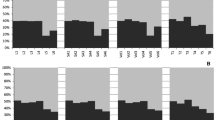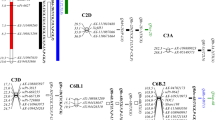Abstract
Vigorous early root growth at seedling stage has been shown to be important for efficient acquisition of nutrients in wheat (Triticum aestivum L.). Identifying quantitative trait loci (QTL) for early root growth can facilitate the selection of wheat varieties with efficient nutrient use. A recombinant inbred line population derived from two Chinese wheat varieties, Xiaoyan 54 and Jing 411, was grown hydroponically at seedling stage. The maximum root length (MRL), primary root length (PRL), lateral root length (LRL), total root length (TRL), and root tip number (RN) of seminal roots were measured using the WinRHIZO Root Analyser. Numerous QTL for the investigated root traits were detected with QTL numbers varying from two to six, depending on the traits. Among them, two loci had major effects on primary (MRL and PRL) and lateral (LRL and RN) root parameters, respectively. The QTL (namely qTaLRO-B1) between Xgwm210 and Xbarc1138.2 on chromosome 2B explained 68.0 and 59.0% of phenotypic variations in MRL and PRL, respectively; the major QTL between Xgwm570 and Xgwm169.2 on chromosome 6A explained 30.5 and 24.5% of phenotypic variations in LRL and RN, respectively. These two major loci showed linkage with previous reported QTL for yield component and nutrient uptake. Detailed analysis of qTaLRO-B1 indicated that the positive allele of qTaLRO-B1 showed dominance over the negative allele, which showed impairment in primary root elongation. The existence of major QTL for root trait and their linkage with agronomic traits and nutrient uptake will facilitate the design of root morphology for better yield performance and efficient nutrient use.

Similar content being viewed by others
References
An DG, Su JY, Liu QY, Li B, Jing RL, Li JY, Li ZS (2006) Mapping QTLs for nitrogen uptake in relation to the early growth of wheat (Triticum aestivum L.). Plant Soil 284:73–84
Araus JL, Slafer GA, Royo C, Dolores SM (2008) Breeding for yield potential and stress adaptation in cereals. Crit Rev Plant Sci 27:377–412
Basten CJ, Weir BS, Zeng ZB (2001) QTL CARTOGRAPHER, Version 1.15. Department of Statistics, North Carolina State University, Raleigh
Chandler VL, Brendel V (2002) The maize genome sequencing project. Plant Physiol 130:1594–1597
de Dorlodot S, Forster B, Pagès L, Price A, Tuberosa R, Draye X (2007) Root system architecture: opportunities and constraints for genetic improvement of crops. Trends Plant Sci 12:474–481
Den Herder G, Van Isterdael G, Beeckman T, De Smet I (2010) The roots of a new green revolution. Trends Plant Sci 15:600–607
Dunbabin V, Diggle A, Rengel Z, Gill G, Mendham N (2003) Breeding more productive grain crops–could selecting the right rooting traits help? In: Solutions for a better environment, Proceedings of the 11th Australian agronomy conference, 2–6 Feb 2003, Geelong Vic, Australian Society of Agronomy. Published on CDROM. ISBN 0-9750313-0-9
Ehdaie B, Merhaut DJ, Ahmadian S, Hoops AC, Khuong T, Layne AP, Waines JG (2010) Root system size influences water-nutrient uptake and nitrate leaching potential in wheat. J Agron Crop Sci 196:455–466
Hai L, Guo HJ, Wagner C, Xiao SH, Friedt W (2008) Genomic regions for yield and yield parameters in Chinese winter wheat (Triticum aestivum L.) genotypes tested under varying environments correspond to QTL in widely different wheat materials. Plant Sci 175:226–232
Helariutta Y, Fukaki H, Wysocka-Diller J, Nakajima K, Jung J, Sena G, Hauser MT, Benfey PN (2000) The SHORT-ROOT gene controls radial patterning of the Arabidopsis root through radial signaling. Cell 101:555–567
Hochholdinger F, Park WJ, Sauer M, Woll K (2004a) From weeds to crops: genetic analysis of root development in cereals. Trends Plant Sci 9:42–48
Hochholdinger F, Woll K, Sauer M, Dembinsky D (2004b) Genetic dissection of root formation in maize (Zea mays) reveals root-type specific developmental programs. Ann Bot 93:359–368
Inukai Y, Sakamoto T, Ueguchi-Tanaka M, Shibata Y, Gomi K, Umemura I, Hasegawa Y, Ashikari M, Kitano H, Matsuoka M (2005) Crown rootless1, which is essential for crown root formation in rice. Is a target of an AUXIN RESPONSE FACTOR in auxin signaling? Plant Cell 17:1387–1396
Laperche A, Devienne-Barret F, Maury O, Le Gouis J, Ney B (2006) A simplified conceptual model of carbon/nitrogen functioning for QTL analysis of winter wheat adaptation to nitrogen deficiency. Theor Appl Genet 113:1131–1146
Li ZX, Ni ZF, Peng HR, Liu ZY, Nie XL, Xu SB, Liu G, Sun QX (2007) Molecular mapping of QTLs for root response to phosphorus deficiency at seedling stage in wheat (Triticum aestivum L.). Prog Nat Sci 17:1352–1360
Liang Q, Cheng XH, Mei MT, Yan XL, Liao H (2010) QTL analysis of root traits as related to phosphorus efficiency in soybean. Ann Bot 106:223–234
Liao M, Fillery IRP, Palta JA (2004) Early vigorous growth is a major factor influencing nitrogen uptake in wheat. Funct Plant Biol 31:121–129
Lim J, Helariutta Y, Specht CD, Jung J, Sims L, Bruce WB, Diehn S, Benfey PN (2000) Molecular analysis of the SCARECROW gene in maize reveals a common basis for radial patterning in diverse meristems. Plant Cell 12:1307–1318
Lim J, Jung JW, Lim CE, Lee MH, Kim BJ, Kim M, Bruce WB, Benfey PN (2005) Conservation and diversification of SCARECROW in maize. Plant Mol Biol 59:619–630
Liu H, Wang S, Yu X, Yu J, He X, Zhang S, Shou H, Wu P (2005) ARL1, a LOB-domain protein required for adventitious root formation in rice. Plant J 43:47–56
Loudet O, Gaudon V, Trubuil A, Daniel-Vedele F (2005) Quantitative trait loci controlling root growth and architecture in Arabidopsis thaliana confirmed by heterogeneous inbred family. Theor Appl Genet 110:742–753
Lynch J (2007) Roots of the second green revolution. Aust J Bot 55:493–512
Maccaferri M, Sanguineti MC, Corneti S, Ortega JL, Salem MB, Bort J, DeAmbrogio E, del Moral LF, Demontis A, El-Ahmed A, Maalouf F, Machlab H, Martos V, Moragues M, Motawaj J, Nachit M, Nserallah N, Ouabbou H, Royo C, Slama A, Tuberosa R (2008) Quantitative trait loci for grain yield and adaptation of durum wheat (Triticum durum Desf.) across a wide range of water availability. Genetics 178:489–511
Osmont KS, Sibout R, Hardtke CS (2007) Hidden branches: developments in root system architecture. Annu Rev Plant Biol 58:93–113
Péret B, De Rybel B, Casimiro I, Benková E, Swarup R, Laplaze L, Beeckman T, Bennett MJ (2009) Arabidopsis lateral root development: an emerging story. Trends Plant Sci 14:399–408
Sanguineti MC, Li S, Maccaferri M, Corneti S, Rotondo F, Chiari T, Tuberosa R (2007) Genetic dissection of seminal root architecture in elite durum wheat germplasm. Ann Appl Biol 151:291–305
Sharma S, Xu SZ, Ehdaie B, Hoops A, Close TJ, Lukaszewski AJ, Waines JG (2011) Dissection of QTL effects for root traits using a chromosome arm-specific mapping population in bread wheat. Theor Appl Genet 122:759–769
Steele KA, Virk DS, Kumar R, Prasad SC, Witcombe JR (2007) Field evaluation of upland rice lines selected for QTLs controlling root traits. Field Crop Res 101:180–186
Su JY, Zheng Q, Li HW, Li B, Jing RL, Tong YP, Li ZS (2009) Detection of QTLs for phosphorus use efficiency in relation to agronomic performance of wheat grown under phosphorus sufficient and limited conditions. Plant Sci 176:824–836
Taramino G, Sauer M, Stauffer JL Jr, Multani D, Niu X, Sakai H, Hochholdinger F (2007) The maize (Zea mays L.) RTCS gene encodes a LOB domain protein that is a key regulator of embryonic seminal and post-embryonic shoot-borne root initiation. Plant J 50:649–659
Tuberosa R, Sanguineti MC, Landi P, Michela Giuliani M, Salvi S (2002) Identification of QTLs for root characteristics in maize grown in hydroponics and analysis of their overlap with QTLs for grain yield in the field at two water regimes. Plant Mol Biol 48:697–712
Waines JG, Ehdaie B (2007) Domestication and crop physiology: roots of green-revolution wheat. Ann Bot 100:991–998
Wang H, Inukai Y, Yamauchi A (2006) Root development and nutrient uptake. Crit Rev Plant Sci 25:279–301
Wysocka-Diller J, Helariutta Y, Fukaki H, Malamy J, Benfey P (2000) Molecular analysis of SCARECROW function reveals a radial patterning mechanism common to root and shoot. Development 127:595–603
Zeng ZB (1994) Precision mapping of quantitative trait loci. Genetics 136:1457–1468
Zhang J, Ju XT, Gao Q, Zhang FS (2005) Recovery of labeled nitrate-N in different soil layers by two crops, spinach and wheat. Sci Agric Sin 38:333–340
Acknowledgments
This research was supported by the National Natural Science Foundation of China (30890133) and the Ministry of Science and Technology of China (2009CB118300 and 2010CB125900).
Author information
Authors and Affiliations
Corresponding authors
Additional information
Yongzhe Ren and Xue He contributed equally to this work.
Electronic supplementary material
Below is the link to the electronic supplementary material.
11032_2011_9605_MOESM1_ESM.ppt
Roots of the parents and selected RILs of the Xiaoyan 54 × Jing 411 RIL population in the first trial. A Roots of the parents Xiaoyan 54 and Jing 411; B roots of the selected RILs. Supplementary material 1 (PPT 326 kb)
Rights and permissions
About this article
Cite this article
Ren, Y., He, X., Liu, D. et al. Major quantitative trait loci for seminal root morphology of wheat seedlings. Mol Breeding 30, 139–148 (2012). https://doi.org/10.1007/s11032-011-9605-7
Received:
Accepted:
Published:
Issue Date:
DOI: https://doi.org/10.1007/s11032-011-9605-7




